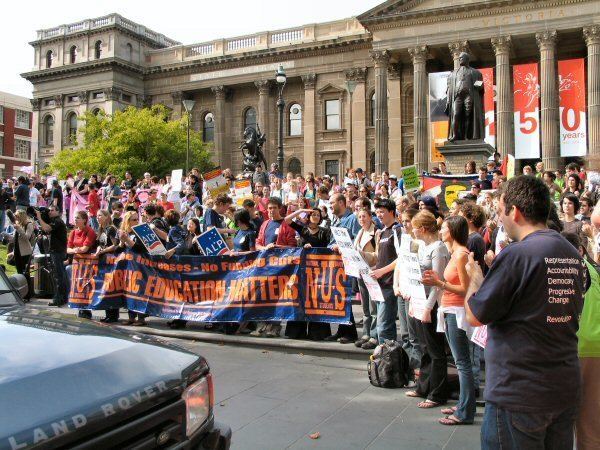Abbreviation NUS National President Sinéad Colee (NLS) | Formation 1987 | |
 | ||
Headquarters Victorian Trades Hall, 54 Victoria St, Carlton South, Victoria 3053 Membership 17 Affiliated University Student Unions | ||
The National Union of Students (NUS) is the peak representative body for Australian university students. As of 2016, 17 student unions in Australian campuses affiliated to NUS. A university is eligible by its classification as a legitimate training provider and the payment of Union fees by the university according to the number of full-time study units of its students.
Contents
History
NUS in its current form came into being in 1987 after the collapse of its predecessor, the Australian Union of Students (AUS), in 1984. The AUS was first known from 1937 to 1971 as the National Union of Australian University Students (NUAUS), before allowing membership of colleges of higher education in 1971, which necessitated a name change.
NUS was formed at the same time that the Hawke government introduced the Higher Education Contribution Scheme (a system of deferred tuition payments), abolishing the free education system previously introduced by the Whitlam government.
NUS has had mixed success in its role as a lobby group and representative body. In particular, its limited finances have often meant that it has had difficulty making its presence felt on higher education issues. It was successful in the early 1990s in preventing the implementation of a deferred loan scheme in place of government student financial assistance, and in reducing the qualification age for student financial assistance.
NUS was unable to prevent the introduction of differential rates of HECS in 1996, but did lobby successfully to stop the introduction of a voucher system by then Federal Education Minister Dr. David Kemp despite later claiming victory in a similar campaign.
The union suffered another major setback in 2003 when despite intense lobbying of independent senators, the reform package of Dr. Brendan Nelson passed the Senate. This package permitted the introduction of Domestic Undergraduate Up-Front Fees (DUFF) by universities in addition to HECS places, and allowed universities to increase their HECS rates by 25%. Components of the legislation introducing VSU, and the mandatory offering of the Australian Workplace Agreement as a component of universities’ enterprise bargaining practices were dropped.
In 2003, NUS membership fees became indexed to consumer price index (CPI) removing some of the strain on the union’s finances. NUS charged $5 per student represented by each member organisation. This raised small fears that many small and regional campus organisations might disaffiliate due to increases in affiliation fees.
In 2006, NUS took a massive budget hit with the introduction of VSU.
In 2016, Australian National University Students' Association voted against accrediting with NUS, citing problems with the conduct of factional delegates at the National Conference. The Adelaide University Union (AUU) voted to cease their SRC from authorising payments of Accreditation to NUS in their March Meeting. The AUU's SRC later condemned the move and restated its affiliation, and intention to pay accreditation fees autonomously.
Delegates and factions
The operations of NUS are dominated by several organised factions, some with close ties to the youth wings of Australian political parties. In 2015, factions operating within NUS include:
Financial and Structural Crisis
In a report commissioned by the NUS secretariat in 2013, independent auditors TLConsult authored a report which cited NUS' "inflexible factional system" as detrimental to the organisation and leading to “historical accounting approach … out of step with modern financial practices”. Auditors "questioned whether some stakeholders generally understood their responsibilities to NUS", citing alliances by some national officers to factions, rather than NUS, as contributing the structural issues faced by the organisation.
The TLConsult audit said that NUS only had enough cash reserves to "sustain the organisation for approximately one year in its current form” and that although voluntary student unionism had resulted in a notable decline in revenue, it was structural problems, “unchanged for nearly two decades”, that were the primary cause of the NUS' current financial problems.
In response to the financial pressures outlined in the audit which cited significant deficits run by NUS over the previous few years, and following outgoing NUS President Deanna Taylor's admission that they “the advice given to NUS is that were our income and expenditure levels to remain status quo, NUS would not exist beyond the next few years”, delegates to the 2014 conference voted in favor of a financial and structural review, and to eliminate the stipend for the positions of National Indigenous, International Students and Disability Officer. However, an attempt to eliminate state officer bearer positions (presidents excepted) was not passed by conference delegates.
National Structure
NUS' national structure is formalised into both a National and State Executives.
National Executive
The responsibilities of the National executive, as subscribed within the NUS constitution, include; setting the budget for the NUS; regularly monitoring of the finances of NUS; employing staff on behalf of NUS; authorising the publication of material on behalf of NUS; and implementing and interpreting the policy of the NUS. The National Executive may also delegate its powers as it considers appropriate.
The members of National Executive are:
Members of National Executive may not hold more than 1 voting position on National Executive at the same time.
The national officers of NUS:
(non-paid national officers)
State Executive
The state branches of the NUS include; New South Wales, Victoria, South Australia, Queensland, Tasmania, the Australian Capital Territory, and Western Australia.
The members of State Executive are:
The state officers of NUS:
Union affiliation
Typically University Student Union's Representative Council's will vote on NUS accreditation. In 2015 accredited university Unions include;
